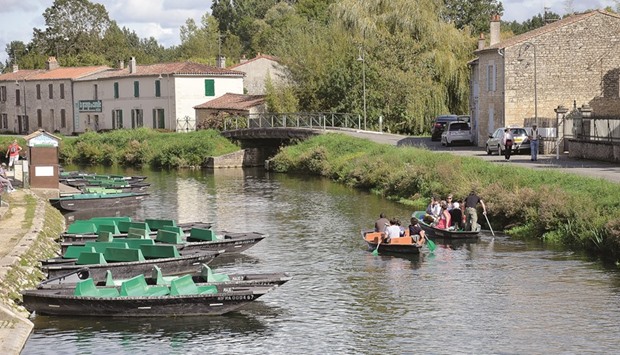It is incredibly quiet on the little canal. To the right, a heron stands motionless in a field. A huge muskrat peers inquisitively through the dense verdure of the river bank.
The branches of the trees on either side meet above the water, earning the Marais Poitevin marshlands the somewhat lofty nicknames of “cathedral of nature” and “green Venice.” To anyone who comes here for a boat trip, both descriptions immediately make sense.
The 100,000-hectare wetland region, which stretches to France’s Atlantic coast, is a natural paradise, a unique ecosystem, and a tourist attraction.
Boats are the most popular means of exploring the Marais Poitevin. In the past, these were fashioned from oak, while today many are made of fibreglass. Until around 1960, several places here were only accessible by boat, with animals, straw, and building materials also having to be transported in this way.
There are plenty of boat tours on offer. One of the most popular spots to embark is the Embarcadere Cardinaud in Magné, a short way east of Coulon, which boasts several snug hotels and restaurants, and a great number of canals.
This is as scenic a spot as any in the region. In places, the marshy landscape takes on an almost surreal quality.
During the peak season in summer, boats set off by the minute from this part of the Marais. But once you enter the seemingly endless system of canals, they are soon only visible in the distance.
You can explore the Marais alone, by following the signposted waterways in your boat, or as part of a tour, with up to 10 passengers perched on narrow benches.
The boatman stands at the stern, punting ahead with his paddle, and pointing out features that would surely otherwise just pass the passengers by.
Those who are busy limit themselves to an hour, although longer tours are available. Some families stay the whole day — including lunch at one of the picnic areas.
The water in the canals flows very slowly. Often, the trees stand so close to the banks that you have to duck your head to avoid their branches.
The area abounds with wildlife. Muskrats — called “ragondin” in French — are prized in the region for their meat. They have to be hunted to control their numbers. Pate de ragondin is considered a specialty and is sold in jars at several locations.
Deer, wild boar, martens, bats, and otters also live in the Marais. And eels of course — another culinary classic.
The marshland around Coulon, Sansais, Le Mazeau or Maille also lends itself extremely well to exploration by bike. Traffic is generally light, even on the small roads. An extensive network of signposted cycle paths, some 850 kilometres in total, connects the many small towns and villages. Some follow the river Sevre or the canals.
Pedalling along the narrow forest paths, the smell of leaves in the air is accompanied by a deep silence, broken intermittently by a cow mooing in the distance.
On the cycle paths, you are alone for kilometres at a time. At one point, you have to dismount to cross a narrow, steep wooden bridge over a canal, the grey-brown water of which seems hardly to be flowing at all. Another time, a pheasant struts across the forest track.
In Village de Sevres, however, there are a surprising number of cars right on the bank. And in front of them sit men in weatherproof clothing on folding chairs, holding their long fishing rods in the water, over which two coots practise synchronised flying.
These are the moments when it is worth stopping and parking the bike, just to take in your surroundings. —DPA

BUSY SEASON: Summer is the busy season in Marais. That’s when the boats at some piers take off every minute.


